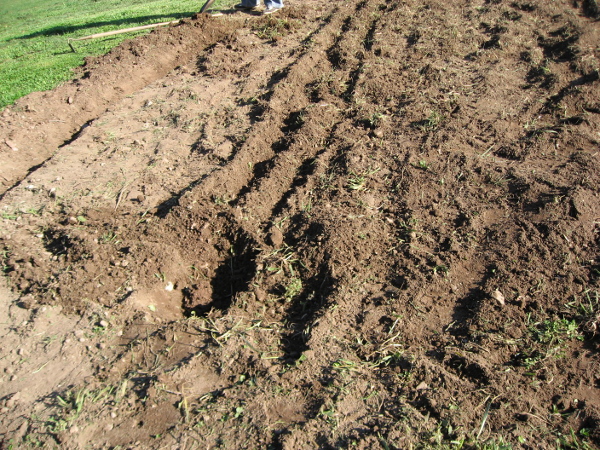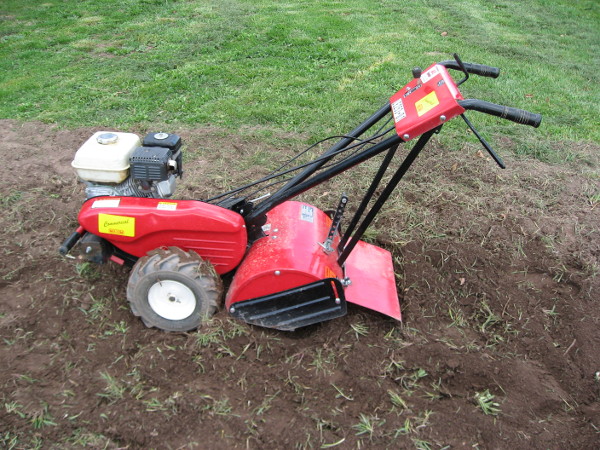Tillers are probably the most popular power tool among home gardeners. The function of the tiller is to break up and loosen hard soil and mix it up, as well as properly mixing other organic matter and manure into the soil in preparation for planting.
It is also commonly used to chop up plant debris and sod and mix it into the soil to convert a plot of land into a garden. A freshly tilled plot of land that was covered in grass can be seen in the image below. A pickaxe and a shovel could get the same job done, but most would consider that back-breaking work, especially if you have a large garden plot. The selection of a tiller should be done carefully to match your soil conditions, abilities and strength, and the size of your garden. The ability of the tiller to perform these jobs is a function of the tiller’s engine size, weight and strength, the tiller design, and types of tines. Material quality and difficulty of repairs must also be considered in the long run. Purchasing a tiller is a large investment, especially for a tool many only use on an annual basis. Most people will find it more economical to rent a tiller or to hire someone to perform the work for them. There are three main varieties of tillers: Front tine, Rear tine, and mini-cultivators. The tines are the metal blades that perform the digging. Both front and rear tine tillers have depth stakes to adjust the level of soil you want to work.

Front Tine Tiller
The front tine tiller typically has forward rotating tines located in front of the machine; the engine sits above or slightly behind the tines to provide weight. Rear mounted wheels make it easy to push the machine from one place to another. When operating the tiller, muscle power is required to tip the tines into the soil to operate the machine and to hold back on the machine to control tilling depth as well as controlling the propulsion of the machine. During the tilling process, the forward rotating tines will tend to pull the machine forward. Leverage is needed for control, but new gardeners are sometimes scared away with the experience of having the tiller run away with them. Virgin ground (untilled) is more difficult to till with a front tine model, because the tines tend to skip over the ground, as opposed to penetrating the soil as desired. This type of tiller is more challenging to handle with rocky soil, as the tines grab hard obstacles; they tend to jump or jerk the machine forward. Because of this, front tined tillers tend to require a little more strength to guide the machine through your plot. For those with experience, operating this type of tiller has been compared to handling a large floor polisher such as those used in schools and hospitals.
In general, the front tined tiller is less complicated and somewhat cheaper than the rear tined tiller, something to consider, as most people don’t use a tiller every day. They are also shorter and more maneuverable and good for small to medium garden plots, or gardens with many tight corners. Probably the biggest drawback of the rear tined tiller is that it tends to be more difficult to use, and also something to consider in making your choice for the perfect garden tiller.
Rear Tine Tiller
Rear tine tillers have the tines located at the rear of the machine. Because they are more complicated and tend to have larger engines, they are generally the most expensive type of tiller. Drive wheels only allow the device to be propelled forward at a set speed, regardless of the forward action of the rear tines. This means the drive wheels can hold it in place so the tines can dig the soil to the desired depth, making it easier to control the tilling depth and making the machine reasonably easy to steer. Forward motion can even be stopped, and the tines will still dig; you can start, stop, speed up and slow down all independent of the tilling action. These units will not tend to jump around when they strike an object because the drive wheels are controlling the forward motion of the machine. Many models will feature variable speeds in the form of gears for hard and soft soils, as well as forward and reverse, which makes it easier to get out of tight spaces. Compost can be “power tilled” with these units as the forward motion of the fast turning tines chop the material and mix it with the soil. Counter-rotating tines (CRT) as opposed to standard rotating tines (SRT) is another feature, which simply means the tines are rotating opposite the direction of travel (rotate towards the rear)- making it easier to break up very tough soil. Some tiller models are available with reversible tine direction (SRT to CRT). The tines could then be placed in forward motion for cultivating or when breaking up soft soils, or in reverse direction for breaking up hard rocky soils. Some models feature swiveling handlebars that allow tilling without the operator walking over and compacting the freshly tilled soil.

Generally speaking, these machines will require the most storage space among the three types of tillers. The rear tined tiller is the heaviest and most powerful tiller, and consequently the most expensive. They are easier to use, especially with rocks or large roots involved, but they are not quite as maneuverable as the front tine tiller and may be difficult to get into some tight corners. The rear tine tiller will give you more control in general over the tilling depth as well as allow for straighter lines. This type of tiller is a must-have for hard or very rocky soils, and also for large garden plots.
For a rear tine tiller with more versatility: Do a Google search for “walk-behind tractor” to see some of the more versatile types of tillers. These machines have a multitude of different attachments (some have several dozens) of accessories ranging from tillers, chipper shredder, snow blower, etc, all utilizing the same engine. This could allow you to have and maintain one large high-quality engine, and you could just switch out the accessories as you need them.
Mini-Cultivators
Mini-Cultivators are smaller versions of front tine tillers, also called soil blenders. They are typically lightweight and portable, and are best suited for working in smaller areas or with relatively soft soil. These particular types of tillers would be well suited for raised bed gardens. The smaller and lighter tines have a tendency to get clogged in some soil types, and are not particularly suited for virgin soil or soil which is very rocky. These could be used on a regular basis, once the garden has been tilled with one of the larger tillers.
1 comment
Thank you, very helpful!